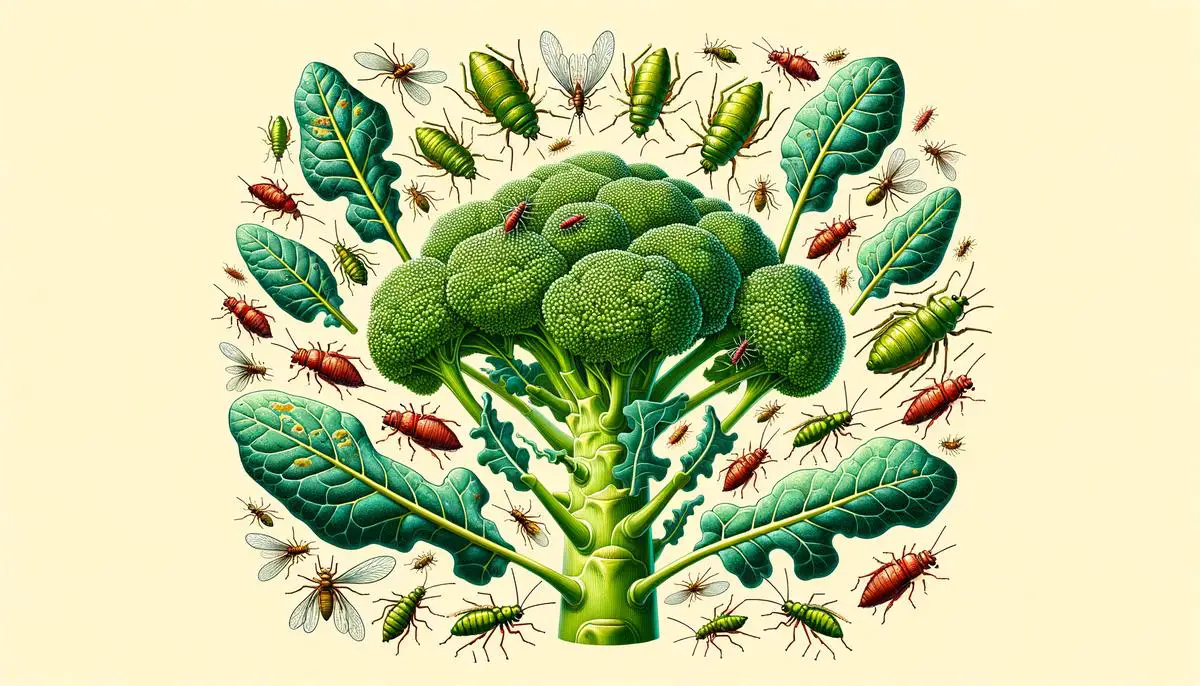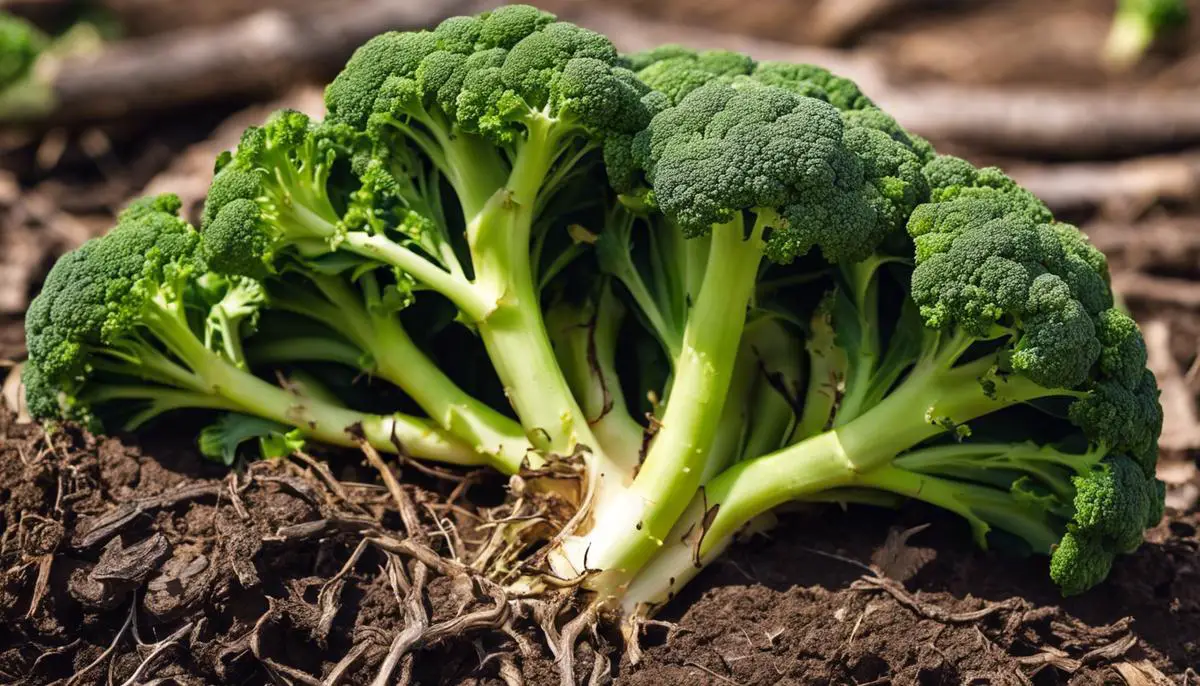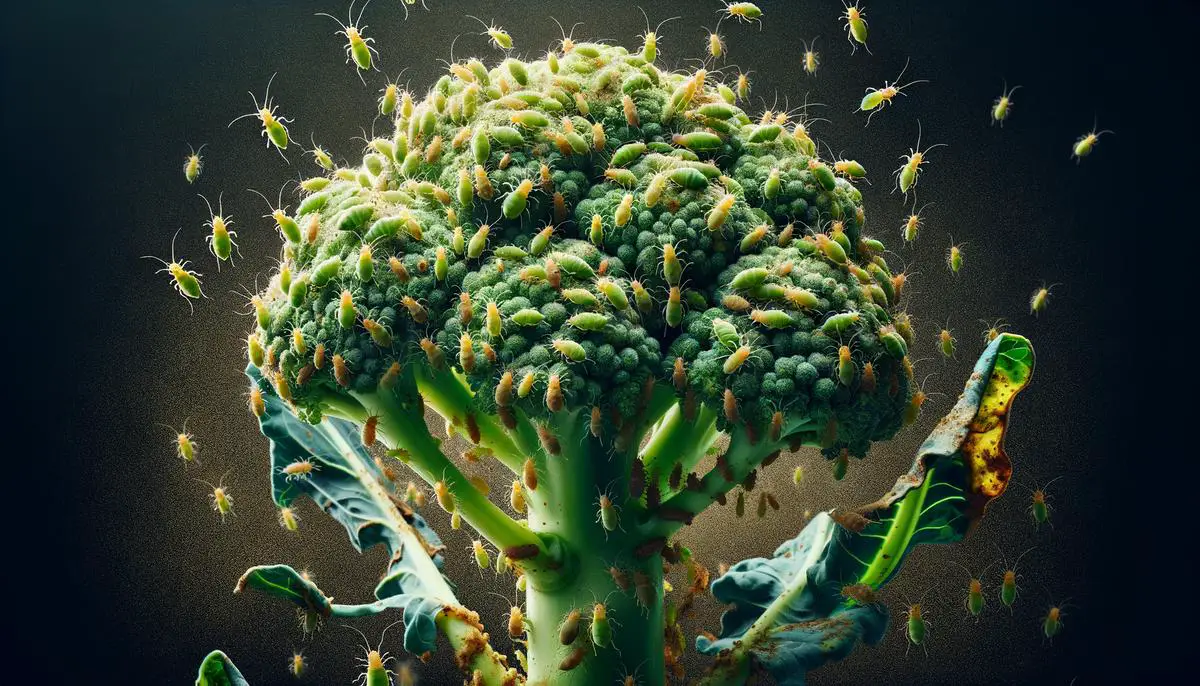Growing broccoli comes with its set of challenges, from dealing with pesky insects to preventing diseases that can harm this nutritious vegetable. In this article, we’ll explore some common problems that gardeners and farmers face when cultivating broccoli, such as aphids, clubroot disease, cabbage loopers, caterpillars, and downy mildew. By understanding these issues and learning effective ways to manage them, you can ensure your broccoli plants remain healthy and productive, offering a bountiful harvest.
Aphids on Broccoli
Aphids, small sap-sucking insects, pose a significant threat to broccoli plants, potentially leading to diminished health and crop yield. These pests, often green or black, congregate in large numbers, feeding on the sap of young shoots and leaves, which can cause the broccoli plants to exhibit stunted growth, yellowing leaves, and a general decline in vigor. Furthermore, as aphids feast on the plant’s fluids, they excrete a sticky residue known as honeydew, which attracts the growth of sooty mold. This mold not only tarnishes the appearance of the broccoli but can also hinder the plant’s ability to photosynthesize effectively, exacerbating the stress on the plant.
Reader Poll: What online courses would interest you?
Fortunately, there are several strategies to mitigate the impact of aphids on broccoli crops. An initial method involves regular monitoring and the physical removal of aphids where possible, which can be done by gently washing them off with a hose or by introducing natural predators such as ladybugs into the garden. For more severe infestations, organic insecticidal soaps or neem oil sprays can be effective, targeting the aphids without causing undue harm to beneficial insects or the environment. In addition, implementing a diverse planting strategy can help deter aphid infestations; plants such as chives, garlic, and onions, when planted in close proximity to broccoli, can serve as natural repellents due to their strong scents. By employing these control measures, gardeners and farmers can protect their broccoli plants from the detrimental effects of aphids, ensuring a healthy and bountiful crop.

Clubroot Disease in Broccoli
Clubroot, a serious disease affecting broccoli and other cruciferous plants, is caused by the soilborne pathogen Plasmodiophora brassicae. This pathogen thrives in moist, acidic soils and can survive for years, making it a formidable challenge for gardeners and farmers alike. Infected plants display telltale symptoms such as wilted leaves, stunted growth, and the development of large, malformed galls on roots, which severely hamper the plant’s ability to uptake water and nutrients. The disease cycle of clubroot is complex, involving resilient spores that can hitch a ride on tools, boots, and even water, spreading to new areas with alarming ease. Its presence in a field can lead to significant yield losses, underscoring the necessity for effective management strategies to protect broccoli crops.
Controlling clubroot begins with proactive measures, starting with the adjustment of soil pH. Since the pathogen favors acidic conditions, liming the soil to achieve a pH above 7.2 can create an environment less hospitable to it. Crop rotation is another vital strategy; avoiding planting susceptible crops in the same location for at least three to four years can help reduce pathogen levels. Resistant varieties of broccoli offer an additional layer of defense, though it’s important to note that resistance may not be absolute under heavy disease pressure. Sanitation practices, such as cleaning equipment and footwear before moving between fields, can minimize the spread of spores. Lastly, improving soil drainage and avoiding the overwatering of plants can lessen the moisture conditions that clubroot thrives in. Together, these integrated management practices can help keep clubroot in check, securing the health of broccoli plants and the viability of harvests.
Subscribe to our newsletter!

Cabbage Loopers and Caterpillars
Combatting cabbage loopers and caterpillars on broccoli crops requires an integrated approach, focusing on prevention, monitoring, and targeted intervention when necessary. Cabbage loopers, the larval stage of a grey moth, and various caterpillar species can devastate broccoli by chewing through leaves, stems, and developing heads, compromising both the yield and quality of the crop. Early detection is key; thus, regular inspection of plants for signs of these pests, including holes in leaves and the presence of frass (insect excrement), is critical. Starting with prevention, the use of floating row covers can physically block these pests from reaching the plants. This method is most effective when applied immediately after planting and secured along the edges to prevent pests from entering.
When an infestation is identified, biological control methods can be highly effective. Introducing or encouraging the presence of natural predators, such as parasitic wasps, ladybugs, and birds, can significantly reduce the population of these pests. Another option is the use of Bacillus thuringiensis (Bt), a naturally occurring bacterium that is harmless to humans and beneficial insects but lethal to caterpillars and loopers when ingested. This organic pesticide should be applied judiciously, targeting the affected areas and minimizing impact on non-target species. In more severe cases, or when biological controls are not sufficiently effective, careful application of insecticides may be necessary. However, selecting products approved for use in organic agriculture and following label directions to protect beneficial organisms is crucial. Regular monitoring after treatment helps ensure that the pest population is managed and further interventions are adjusted as necessary.

Downy Mildew in Broccoli
Downy mildew, caused by the organism Peronospora parasitica, presents a significant threat to broccoli crops, leading to diminished yields and compromised quality. This disease is particularly adept at taking hold in cool, moist environments, where it rapidly proliferates, laying siege to the leaves of the plants. Initial manifestations include yellow areas on the upper leaf surface, which soon become underlain by fluffy, grayish-white fungal growths on the underside. As the disease progresses, these affected areas can become dry and necrotic. The repercussions for the broccoli plant are severe, with photosynthesis impaired, the plant’s growth stunted, and, in the worst cases, leading to the death of young seedlings or significantly weakened mature plants, rendering them more susceptible to other diseases and environmental stresses.
To stave off the insidious advance of downy mildew, several preventative measures can be instituted. Firstly, ensuring good air circulation around the plants by spacing them adequately can significantly reduce humidity levels, creating a less hospitable environment for Peronospora parasitica. Furthermore, employing drip irrigation as opposed to overhead watering diminishes the moisture on the leaf surfaces, further discouraging the development of downy mildew. For those seeking to get ahead of the problem before it even begins, selecting resistant varieties of broccoli provides an essential line of defense, empowering the plants to withstand infestations more robustly. In scenarios where downy mildew has been previously problematic, crop rotation is highly recommended to prevent the pathogen’s spores from building up in the soil and affecting the subsequent broccoli crops. Lastly, the vigilant monitoring of crops for early signs of the disease enables the early intervention, which can be critical in mitigating the spread and impact of downy mildew, preserving the health and yield of the broccoli plants.

Keeping broccoli plants healthy and thriving involves a proactive approach to managing pests and diseases. By employing strategies like choosing resistant varieties, improving soil conditions, and using biological controls, gardeners and farmers can effectively protect their crops. While challenges may arise, the rewards of having a successful broccoli crop are well worth the effort, providing not just a source of food but also the satisfaction of overcoming obstacles in the garden. Remember, a healthy plant is the foundation of a plentiful harvest, and with the right care, your broccoli can flourish.

